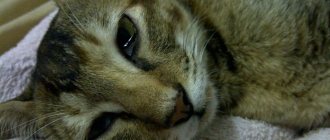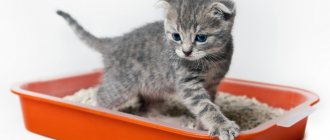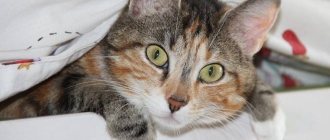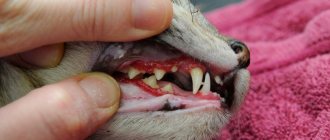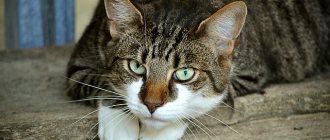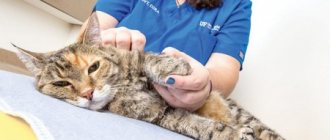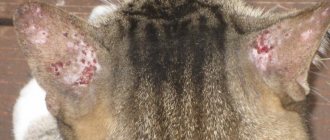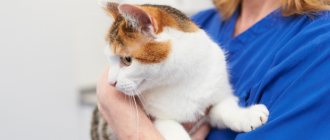Signs of feeling unwell
It is important to notice changes in the cat’s well-being in a timely manner, because only timely assistance can be most effective.
Signs that should alert the owner:
- Refusal of food or gluttony. It is worth noting that seasonal changes in your pet's appetite are possible. Usually by winter cats gain weight and therefore eat more, but by summer their appetite drops a little and they lose weight. And yet, a sudden refusal to eat may indicate a pet’s illness, as can a suddenly awakened strong appetite for no reason.
- Apathy, lethargy. Cats are usually quite lazy creatures. As they age, they play less and sleep more. However, a healthy animal should still have periods of activity when it runs around the house, sits on the window and looks at birds, and hunts. If the cat has become inactive, constantly sleeps, is passive, and is not interested in the world around him, this is a reason to sound the alarm.
- Problems with urination, blood in the urine.
- Vomiting and diarrhea. Sometimes cats may vomit for no reason - this is how they clean their stomachs of ingested fur. Still, it’s worth keeping a close eye on your pet. If the vomiting does not stop, or the animal has severe diarrhea, it is necessary to take the pet to the doctor.
- Discharge from nose and eyes.
- Increased body temperature. Normal body temperature in cats is 38-39 degrees.
- Shortness of breath, wheezing, cough.
Street cats are often injured in fights with other cats or dogs. How to cure a cat in this case? If the wound is small, it can be treated with hydrogen peroxide. For more serious injuries - fractures, large lacerations, internal injuries - you should contact a veterinarian as soon as possible. The doctor must stop the bleeding, treat the wound, and fix the broken limb. Usually the animal is injected with an anesthetic. Afterwards, it is advisable to leave the animal in a dark, quiet place where no one will disturb it.
We will list the main diseases of cats, their causes, symptoms and tell you how to cure a cat at home.
How do cats heal people?
How cats manage to have a beneficial healing effect on the human body was explained with the help of modern equipment used by scientists to study the phenomenon. Science has confirmed and substantiated what our ancestors knew thousands of years ago.
Purr
A special frequency of sounds, lying in the range of 20-50 Hz, stimulates regenerative processes in the body, improves bone healing after fractures, cracks, increases the rate of restoration of cartilage tissue, and accelerates wound healing.
Purring is close in frequency to ultrasound, which is actively used in the treatment of various diseases. For the experiment, the chickens were placed daily on a surface that imitated the sounds of purring for 15 minutes. The experimental chicks grew faster than the second part of the brood, their bones became stronger and grew at an accelerated pace.
Hot water bottle effect
The normal temperature of a cat’s body is higher than that of a human (37.5 – 39.5°C). Lying on a sore spot the animal creates a warming effect, and a slight temperature difference does not provoke the stimulation of inflammatory processes or the proliferation of pathogenic organisms.
Such heating alleviates conditions during exacerbation of radiculitis and osteochondrosis.
Biocurrents
The friction of cat hairs creates microcurrents. Studies have shown their effectiveness in the treatment of joint diseases - arthritis, bursitis, arthrosis.
Be sure to read:
Cats in ancient Egypt: their meaning, features of appearance and character, education and training
The effect of the furry doctor's currents is beneficial for women suffering from menstrual pain, inflammation of the appendages, and cystitis. It is enough to place the cat on the lower abdomen for 20-30 minutes, and relief will come.
Emotional background
Nervous tension is dangerous for people with cardiovascular diseases; it can weaken the immune system, provoking an exacerbation of chronic pathologies and infectious diseases. Communication with a cat relieves nervousness and normalizes blood pressure.
The comfort and peace emanating from an animal dozing nearby is relaxing; playing with it, fussing, and the pet’s funny tricks relieve stress, switch thoughts, and give a positive attitude. Among older people, cat owners have a longer life expectancy, remain active longer, and are less susceptible to age-related depression, this is caused by the need to take care of their little friend, which does not allow them to lose their tone.
Parasite infestation
A fairly common problem, especially for outdoor cats, is infestation with parasites. Cats can catch them from other animals, through food, even from their owner’s street clothes and shoes.
Very often cats, especially outdoor ones, are sick with worms. The main symptoms: the animal eats a lot, but does not gain weight, the cat’s stomach is swollen, activity decreases, long white worms can be found in the feces that wriggle and move.
How to cure a cat? It is necessary to purchase anthelmintic drugs from a veterinary pharmacy; it is advisable to consult a veterinarian before purchasing. The medicine should be given according to the weight of the animal. After the first dose, it is advisable to give anthelmintic drugs again after a few days and monitor whether the worms come out in the feces. Treatment can be completed when no parasites are found in the stool. It is advisable to give anthelmintic drugs to animals prophylactically in accordance with the instructions. And this also applies to domestic cats.
Outdoor cats become infected with fleas very easily. If your cat is constantly itching, his activity level decreases, and he is constantly tense, it is worth checking his fur for the presence of fleas. You can get rid of fleas using special shampoos, drops and collars. It must be remembered that fleas can lead to anemia, infection, and wounds on the skin from claws.
Effective treatment of cats with folk remedies
When a beloved pet gets sick, the question of how to treat it becomes quite acute. Many people treat cats with folk remedies. This is quite natural, since traditional drugs of chemical origin are dangerous due to their side effects. However, do not rush into self-medication. Often, you cannot do without contacting a veterinarian, since first you need to make a correct diagnosis, and then experiment with decoctions and lotions.
In addition, an accurate dosage is needed, taking into account the individual characteristics of the mustachioed patient and the severity of the disease. Treatment of cats with folk remedies should be carried out according to a certain scheme, because many medicinal plants contain toxic substances. To achieve an optimal positive effect, it is important to use any drugs according to the regimen and strictly in a certain quantity.
Digestive problems
Quite often, owners feed domestic cats from the table, that is, they give them food that they eat themselves. This is absolutely the wrong approach. The cat's body is fundamentally different from that of humans, which is why their food must be different. As a result of improper feeding, cats may develop problems with the stomach and intestines, kidneys, and urinary system. It is worth remembering that a cat can be fed natural food, but only in accordance with a specially formulated diet, which must contain all the vitamins, minerals and beneficial components the animal needs.
Another common problem that can cause digestive problems is feeding low-quality food. Widely advertised inexpensive food from the economy segment can lead to problems with the liver, kidneys, stomach and intestines. Cheap cat food often causes diarrhea and vomiting.
Diarrhea and vomiting in a cat may also indicate poisoning of the animal. The cause may be: poor quality, rotten food, eaten by a poisoned mouse or rat, poisoning from household chemicals. In this case, you must consult a doctor as soon as possible, otherwise the consequences may be irreparable.
Do cats heal humans?
The results of a survey conducted in 2020 with the support of the famous pet food manufacturer Purina showed that 90% of respondents are confident that cats change the emotional background of their owners to a more positive one, 80% of Russians believe that purring can improve the mental and physical state of the owner, and 79% believe in their healing abilities, eliminating diseases.
Indeed, people who keep animals notice that cats come to a sick family member and try to lie down on the sore spot.
It has been scientifically proven that children growing up next to cats have stronger immunity than their peers “deprived” of pets, and are less likely to be diagnosed with allergies and asthma.
There is even feline therapy - a treatment for cats used by official medical institutions. Fluffy doctors are employed in one of the British clinics, helping to reduce blood pressure in patients, are used in rehabilitation centers, and help patients with cerebral palsy and autism.
Nervous system dysfunction
The main symptoms of problems with the nervous system:
- sudden aggression;
- paralysis of the limbs or the whole body;
- neurotic states: sudden hysterics, constant depression, radical changes in behavior;
- rachiocampsis.
Problems with the nervous system can arise due to injuries, congenital pathologies, hormonal imbalance, or accompany other diseases.
In case of the first symptoms, you should immediately consult a doctor.
Basic rules of cat therapy
The animal itself strives to help the sick person, coming to bed, lying next to him while the owner watches TV or reads. At this time, you can stroke the cat, take it into your arms, lay it on your knees, or chest.
Be sure to read:
Do cats understand people: how they recognize through intonation, gestures and smell, cat telepathy.
It is impossible to hold it by force, the patient will not receive a positive effect from forced contact, and negative energy will be harmful to the animal.
There are often cases when pets in advance delay the psychosomatic illnesses of their beloved owner. For example, a woman could not part with her husband due to certain circumstances; in conversations with relatives and acquaintances, phrases were often heard from her: “I can’t digest it,” “I feel sick,” “it’s painful,” related to her husband.
Six months later, her cat began to have problems with the digestive system that had no objective reasons. The treatment didn't help much. When they managed to get a divorce, these figures of speech disappeared from the lexicon, and the pet recovered. Coincidence? Perhaps, but there are hundreds of such cases.
Urolithiasis disease
Urolithiasis is a very common and dangerous pathology in cats. Due to improper functioning of the kidneys, sand and stones form in them, which clog the urethra. Urine cannot come out, which causes intoxication of the animal’s body. This problem is especially common in neutered cats.
The main signs of urolithiasis:
- painful urination;
- the animal sits on the tray for a long time and cannot urinate;
- blood in urine.
Causes of urolithiasis:
- Feeding with low-quality dry food and lack of constant access to clean drinking water.
- Frequent feeding of fish.
- Excess weight, which causes disturbances in the functioning of internal organs.
Urolithiasis can cause the rapid death of an animal. At the first symptoms, you must immediately show your pet to a doctor.
How to cure a domestic cat? Your cat may need surgery to remove stones from the urethra. Afterwards, the doctor will prescribe medication and a special diet. It is necessary to strictly adhere to all the veterinarian’s recommendations, since urolithiasis does not simply go away and if the treatment regimen and diet are violated, it may worsen.
What to do at home?
If your cat's cold is mild, it can be treated at home. Before treating with medications, it is worth observing the animal and trying to relieve the symptoms of a cold. If there is no improvement within 24 hours, then you should urgently consult a veterinarian, he will prescribe antibiotics that will help cure the animal. If the cat’s condition stabilizes, then most likely he will cope on his own. The most common home remedies to help treat your pet are:
- If your cat has a cold, then first of all you need to give it rest.
- The pet needs a warm and dry room; under no circumstances should it be in a draft.
- A sick animal needs an increased drinking regime. You can give him warm milk.
- You can make warming compresses and heating pads; at this time, the cat’s blood flow increases, so it will warm up faster. In this case, recovery will take much less time.
- The nasal passages need to be cleared by cleansing measures. Why roll a cotton pad into a tube and clean your pet’s nose with it. If the cat does not have an allergic reaction, then instead of boiled water, you can use a decoction of chamomile, calendula or sage.
- If a cat has a cold and its nose is not breathing, then you can drip a few drops of eucalyptus onto the bedding on which the animal sleeps. This will make it easier for him to breathe.
- It is good to treat an animal with a massage; it has a warming effect.
- If your pet is sneezing and has a runny nose, you can blow pre-poured streptocide into his nostrils.
Eye problems
During street fights, cats often injure each other's eyes. Main symptoms: blood streams from the eye, the cat cannot open the eyelid, the animal screams in pain, damage is clearly visible on the eye. How to cure a cat? In this case, you should seek help from a doctor as soon as possible. He will clean the eye and check its condition. If the eye does not have to be removed, the veterinarian will prescribe injections, and the affected organ of vision will need to be washed several times a day.
Swelling of the eye, clouding of the pupil, constant tearfulness or discharge of pus can indicate a variety of diseases. Most often, cats suffer from conjunctivitis, glaucoma, and cataracts. Only a doctor can make an accurate diagnosis by taking the necessary tests. How to cure a cat in this case? The doctor may prescribe antibiotics and other medications. You will have to rinse out the pus from your eye at home, use eye drops, or take prescribed injections.
Features of treatment
Once a diagnosis is made, work with your doctor to develop a treatment plan. Decide what procedures you can perform at home. For example, it is quite easy to master intramuscular or subcutaneous injections or give tablets and mixtures orally. You can even install IVs at home. The veterinarian will install a catheter in the animal's vein, which must be changed every three days. Moreover, such a simple procedure as an enema or gastric lavage can become a real problem for the owner. It would be better if a nurse at the veterinary clinic does this.
Ask to find out exactly what medications are prescribed for the cat. Choose the appropriate form of the drug. For example, if a cat has constant vomiting, instead of tablets and drops, it is better for him to administer medications subcutaneously or intramuscularly.
Doctors often prescribe dietary supplements along with antibiotics and other strong medications. If you do not consider it necessary to give them to your pet, you can refuse such supplements. But you can’t save on important medications.
Infection
Another common problem in cats is ringworm. The animal may develop bald patches, the cat itches a lot, and red spots and scales appear on the skin. Ringworm is an extremely contagious disease, including for humans. Its appearance is caused by mold fungi. Initially, the disease is localized on the tail, head and ears, and if left untreated, it spreads to the entire body.
How to cure lichen in a cat? It is worth understanding that all the symptoms indicating lichen do not guarantee that it is not some other disease. Therefore, lichen must first be correctly diagnosed. The veterinarian may take a scraping from the cat's skin and send it for analysis or use a Wood's lamp. When making a diagnosis, the doctor must vaccinate the animal.
How to cure a cat's lichen at home? It is worth remembering that lichen is extremely contagious, and therefore it is better to touch the animal only with gloves. It is advisable to temporarily isolate the cat from people and other animals. For treatment, you can use antifungal ointments, baths with lime sulphide, tablets (Itraconazole, Terbinafine, Griseofulvin).
There are also infectious diseases that cats often suffer from: feline distemper, rabies, coronaviruses, calcivirus. The main symptoms of an infectious disease are: high fever, vomiting and diarrhea, apathy, drowsiness. Whether a cat can be cured depends only on the accuracy of the diagnosis and how quickly the animal receives medical help. In the case of infectious diseases, minutes often count.
What diseases can cats treat?
Eastern medicine, specializing in the energies of the human body, divides diseases into those arising from a lack of prana (yin), which include chronic fatigue, hypertension, arthritis, drowsiness, poor memory and excess (yang), expressed in hyperreactivity, nervous excitability, intestinal dysfunction, gallbladder, bladder.
Cats successfully cope with both cases, absorbing excess negative energy, sharing positive energy with the owner, leveling the balance. Regular communication with your pet is the prevention of heart attacks, strokes, the development of atherosclerosis, thrombosis, neurasthenia, insomnia, hormonal imbalance, metabolic disorders, gynecological and urological pathologies.
Prevention
Let's highlight the main methods of preventing diseases in cats:
- feeding only high-quality, balanced feed;
- food must be selected in accordance with the age and characteristics of the cat (for example, for neutered animals it is advisable to buy specialized food);
- constant availability of clean drinking water;
- annual vaccinations even for cats that do not go outside;
- periodic examinations of the animal by a veterinarian.
Thus, often an animal that is kept in the right conditions and fed with high-quality feed has a stronger and more disease-resistant immune system. It is worth remembering that self-medication in case of illness can further aggravate the situation, therefore, at the first opportunity, it is advisable to show the sick pet to a specialist.
Causes of the disease
The disease can occur for a number of reasons, including:
- Improper maintenance of a mustachioed pet. A cat can become hypothermic while outside or on a balcony; catch a cold due to drafts moving around the room; “earn” a runny nose if the hair remains wet after washing.
- Viral infection. Pets can become ill by contracting the disease from sick street animals.
Incorrectly selected food, lack of proper care, and the presence of chronic illnesses weaken the body’s immune system; weakened immunity contributes to the development of colds.
If the owner is confident that the animal is being kept properly and there are symptoms of the disease, then it is necessary to treat the animal for a viral infection.
Veterinarians call the disease “rinotracheitis”, it refers to complex diseases, the causative agent is a virus located in the external environment, found in the urine, feces, and secretions of a sick individual. Can be transmitted through direct contact by airborne droplets.
A cat that doesn't go outside can still become infected. The pathogen can enter the apartment by ending up on the owner’s street shoes or clothes.
Therapeutic tactics
If a runny nose is caused by a common cold caused by hypothermia of the pet’s body, then you can use time-tested methods, one of which is warming up. To do this, heat sea salt in a frying pan, let it cool slightly and put it in a handkerchief. Apply the resulting bag warm to your pet’s nose and trim for several minutes. It is recommended to repeat the procedure daily for 5–7 days. Heat can be used for therapy only in the absence of bacterial flora.
Sea salt can be used to warm your pet's nose
You can also use aloe juice to eliminate rhinitis. In this case, you need to select the lowest leaf and put it in the refrigerator for half an hour, after wrapping it in parchment paper. Then rinse thoroughly and cut, carefully squeezing the juice into a glass container.
The healing liquid should be injected into the pet’s nose, one drop at a time, using a pipette. It is enough to carry out the procedure 1-2 times a day. The course of treatment should not exceed a week. If, while using aloe juice, the symptoms intensify and discharge from the eyes appears, then it is recommended to try another method.
Aloe has an anti-inflammatory effect
A good remedy to speed up recovery is beet juice. To obtain it, just rinse a small root vegetable and grate it. Then transfer the resulting mass to cheesecloth and squeeze the juice into a glass container. Use 2 times a day, 1 drop in each nasal passage for 5 days. It is not recommended to increase the dosage of juice, otherwise you may provoke unwanted reactions.
Beetroot juice speeds up recovery from a runny nose
You can use saline solution for rinsing. It is enough to inject 2-3 drops into each nostril 2-3 times a day. Treatment can be stopped after the symptoms of rhinitis completely disappear. In combination, you can use the drug Glazolin 1 time before bedtime. One drop into each nasal passage is enough to significantly ease your pet's breathing. The course of treatment with this drug should not exceed 5 days, otherwise it can cause addiction to the drug.
Glazolin relieves nasal congestion
If it is difficult for your pet to breathe due to excessive mucous secretions, then children's Naphthyzin can be used for therapy, which constricts the vessels of the nasal mucosa. In this case, it is enough to inject one drop into each nostril. It is prohibited to use this medicine for more than 4–5 days. The drug can be instilled only once a day to avoid drying out the mucous membrane.
Naphthyzin constricts blood vessels, relieving swelling of the mucous membrane
If the symptom occurs as a result of injury to the nose, then no special treatment is required. Rhinitis will go away immediately after the wound heals. However, to speed up this process, it is recommended to treat the damaged surface with Miramistin 2 times a day until complete healing. The procedure should be carried out using a cotton swab, and rinsing the nose should be done using a pipette.
Miramistin is active against bacteria, viruses and fungi
Attention! If the symptoms of rhinitis do not stop within a week, this may indicate a bacterial or viral nature of the disease.
Non-infectious
Next, we will consider diseases that have nothing to do with parasites or infection. Such diseases are the most difficult to treat, since there is no pathogen as such. In this case, many owners refer to a virus or bacteria, which is why incorrect treatment is carried out.
Fading kitten syndrome
This is a terrible condition when a kitten is born “premature”, very weak and exhausted.
The syndrome occurs in newborn kittens who, for one reason or another, did not receive enough nutrients in the cat's womb. Babies have a quarter less body weight than healthy kittens.
At the same time, the cat does not show any special attitude, which is why weak brothers do not have the opportunity to eat normally or keep warm, since they are pushed aside by healthy animals.
Symptoms:
- Body temperature is reduced by several degrees, most often 34 °C.
- The heart beats very slowly, and the breathing rate also decreases.
- The kitten practically does not move, constantly lies on its side.
- Severe convulsions and long-term cessation of breathing occur.
- A coma state is observed.
Important! Once a kitten begins to have convulsions and stop breathing, it is no longer possible to return it to its normal state.
A weak kitten can be cured only if it does not have serious pathologies that will interfere with feeding or defecation. Animals with severe deformities have no chance to survive.
To save a weak kitten, immediately after birth it must be placed in a kind of “incubator”, where a high temperature will be maintained.
Feeding is provided only by you, since a weak kitten will not be able to suckle milk from a cat, and besides, the mother may be sick, which will clearly worsen the condition of the fluffy.
Treatment does not end with care, but requires the intervention of a specialist. It is dangerous to take a weakened kitten to the veterinarian, so you should call a doctor at home. He will examine the kitten and then prescribe the necessary medications that will strengthen the immune system or promote recovery.
Toxic milk syndrome
Mother cat milk can turn into poison for kittens. This happens because the cat develops diseases such as septic mastitis, inflammation of the mammary glands, inflammation of the uterus and others.
As a result, substances enter the milk that poison the body of small kittens.
Symptoms:
- Wasting in kittens.
- Diarrhea and bloating.
- A pitiful meow.
- The anus becomes red and slightly swollen as a reaction to loose stools.
Treatment consists of eliminating the source of the problem.
If a cat's milk causes poisoning in kittens, then the young animals need to be switched to artificial nutrition, after which the digestive system will work as it should. At the same time, it is necessary to remove toxins from the weakened body of kittens, otherwise their cleansing organs simply cannot cope with the poisons.
To do this, subcutaneous administration of isotonic solutions is prescribed, which remove toxic substances.
Homeopathic medicines based on herbs are also used.
It is worth understanding that poisoning in small kittens is similar to poisoning in small children. If the toxic substances are not removed in time, the animal will die.
Hypogalactia in cats
Hypogalactia is an insufficient production of milk by the cat’s mammary glands, as a result of which the kittens do not receive enough “feed”, partial dehydration occurs, and growth and development are inhibited.
A similar problem arises for the reason that a cat produces milk exclusively after exposure to nipple receptors. That is, milk will begin to be released only when the kitten begins to suck on the nipples.
The problem also occurs in cats that give birth for the first time, or in those whose litter is too large. If the animal is poorly fed or suffers from dehydration, then milk will be produced in minimal quantities.
Symptoms:
- Kittens are very restless, constantly trying to get closer to the mammary gland.
- The cat is nervous and pushes the kittens away.
- A cat spends very little time feeding her brood.
There is no treatment as such.
Either you improve the cat's diet, after which milk production improves, or you transfer the kittens to artificial feeding. Sometimes it can help to pre-massage the cat’s nipples so that they acquire the desired shape and the receptors give a signal and milk production begins.
Important! You need to increase the calorie content of your cat's diet, not the variety.
Anemia and hemolysis
Anemia is a syndrome in which the level of hemoglobin in the blood is significantly reduced. To put it simply, this is anemia.
For anemia, Helavit is used.
Hemolysis is the process of destruction of “old” blood cells. The pathological variant differs in that the blood cells are destroyed ahead of time, which causes hemolytic anemia.
Causes:
- The process of formation of blood cells is disrupted.
- The process of “waste” blood cells is disrupted.
- The balance between the production and destruction of blood cells is not maintained.
- Genetic failure.
Blood is produced by the bone marrow and destroyed in the spleen.
Deviation from the norm of blood production/“utilization” causes anemia, which indicates a functional disorder of the organs. Symptoms:
- The mucous membranes lose color or appear blue.
- The heart rate increases and shortness of breath appears due to dysfunction of the heart muscle.
- The kitten is sick, does not eat or drink anything, and constantly lies down.
- Kittens grow poorly and lose weight.
- Possible indigestion.
Treatment depends on the type of disease.
If posthemorrhagic anemia, which is characterized by hemorrhage (external or internal), has been diagnosed, then efforts are directed toward stopping the bleeding, after which hemostatic drugs are prescribed, as well as those that increase blood clotting to prevent recurrent hemorrhage.
The hemolytic variant occurs because new blood cells are quickly destroyed due to the action of poisons, viruses or microparasites.
Initially, the veterinarian prescribes a medicine that is designed to destroy the pathogen.
Next, medications are prescribed that remove poisons from the blood, as well as medications with iron that restore hemoglobin levels.
Dehydration
Dehydration is a decrease in the amount of water in the body below the physiological norm, which causes malfunctions of all organ systems, including at the cellular level. Accompanied by metabolic disorders.
Most often it occurs not due to a lack of water, but due to the rapid removal of fluid from the body. Dehydration can be caused by vomiting, diarrhea, or excessive sweating. Dehydration is also a “companion” of various diseases in which the animal refuses water and food.
It is worth mentioning separately about diseases and disorders that lead to dehydration, namely:
- Diabetes.
- Chronic pathologies.
- Kidney diseases.
Symptoms:
- Mild weakness (with loss of less than 6% fluid).
- The mucous membranes dry out and lose color. Saliva becomes sticky (less than 8%).
- Dryness of the mucous membranes of the eyes, as well as cold extremities (more than 10%, direct danger to life).
Before treating the disease that caused dehydration, you need to restore your water balance. To do this at home, you should move the animal to a cool place, and then give it water at room temperature from a syringe without a needle.
Next, you should call a veterinarian if the kitten does not drink or the condition does not improve.
Intravenous fluids will be required to restore fluid balance. Only after the symptoms of dehydration disappear can you proceed to treatment of the underlying disease, if any.
Did you know? Cats have glands on their faces that secrete a special smelling secretion. Cats rub against our legs and arms in order to mark their territory with this secret.
Hypothermia
Hypothermia is dangerous for newborn kittens, as they cannot regulate their body temperature on their own. In the first two weeks of life, babies resemble cold-blooded animals, since their condition directly depends on the ambient temperature.
The cat must keep the kittens warm, but not all animals fulfill their “duty.” If a cat has problems with the nervous system or is afraid of something, then she will not be interested in taking care of kittens. Sometimes an animal believes that its task is to warm and feed only the strongest, while the weak will die anyway.
Hypothermia in kittens also occurs if the room temperature drops below 20 °C.
Kittens that are underdeveloped or have deformities will always be cold because they are too weak to survive at optimal room temperatures. Such individuals need “greenhouse” conditions.
Symptoms:
- The animal is constantly trembling.
- Apathy.
- The kitten constantly wants to sleep, tries to hide in the farthest dark corner.
- Decrease in temperature.
- Slow breathing and heartbeat.
- Strange behavior.
Mild hypothermia is “treated” with slow passive warming.
It is necessary to move the animal to a warmer place, and then wrap it additionally to keep warm. In case of moderate or severe hypothermia, call a veterinarian immediately.
The situation requires not external, but internal warming, for which intravenous warming compounds are administered, as well as a warm enema. Sometimes an inhaler is used to bring warm air into the animal's body.
Since we are talking about small kittens, not all means can be used, so you need to call a specialist as quickly as possible to save the little one.
Important! Hypothermia can negatively affect internal organs, so diagnosis must be carried out.
Inflammation of the navel
A problem associated with the umbilical cord that occurs due to infection. If the mother bites the umbilical cord incorrectly, and normally it should be several centimeters long, then an open wound appears, into which any infection can get.
Often the cause of infection is dental disease in the mother, which during snacking introduces the infection into the baby’s body. Also, the cause of infection may be unsanitary conditions in the kittens’ habitat.
Symptoms:
- Refusal of food.
- Depressed state.
- Increased body temperature.
- Swelling and suppuration of the navel.
Important! The umbilical cord is directly connected to the liver, so lack of treatment leads to blood poisoning.
To begin with, the umbilical cord is treated with antiseptics, after which drugs are applied that relieve inflammation. Next, special antibacterial compounds are injected into a vein or muscle, which are designed to prevent blood poisoning.
Separately, it is worth mentioning that for prevention, the umbilical cord is treated with iodine immediately after birth.
Most often, cat breeds such as Siamese, exotic shorthair, British, and Thai are chosen as pets.
Identifying symptoms
Lethargy and constant fatigue in a cat
Not all owners are able to answer the question of whether a kitten can catch a cold from a person. Many owners are not even aware that their pets can get the same diseases as people. Meanwhile, the symptoms of a cold are as follows:
- The animal becomes lethargic and passive and stops playing. Kittens are not prone to refusing to play. If your pet is showing signs of being unwell, it could be sick.
- The kitten has lost its appetite. This behavior also gives cause for concern.
- Your pet's ears and nose become warm. Experienced cat owners know that a healthy pet's nose should always be cold and moist.
- The animal sneezes and coughs. The eyes become watery and the third eyelid is drawn in. These are also symptoms of infection.
In an adult, the signs of a cold will be the same as in a baby. There is no need to make a diagnosis yourself. Noticing the pet's watery eyes, the owner begins to treat the cold. Meanwhile, kittens often develop another dangerous disease - rhinotracheitis.
Rhinotracheitis is an acute viral infection whose symptoms are similar to those of a cold. The disease requires an integrated approach. The animal must be given not only antiviral drugs, but also immunomodulators. The diet should also be reviewed.
The veterinarian, not the owner, should choose the dosage and the right products for the daily diet.

